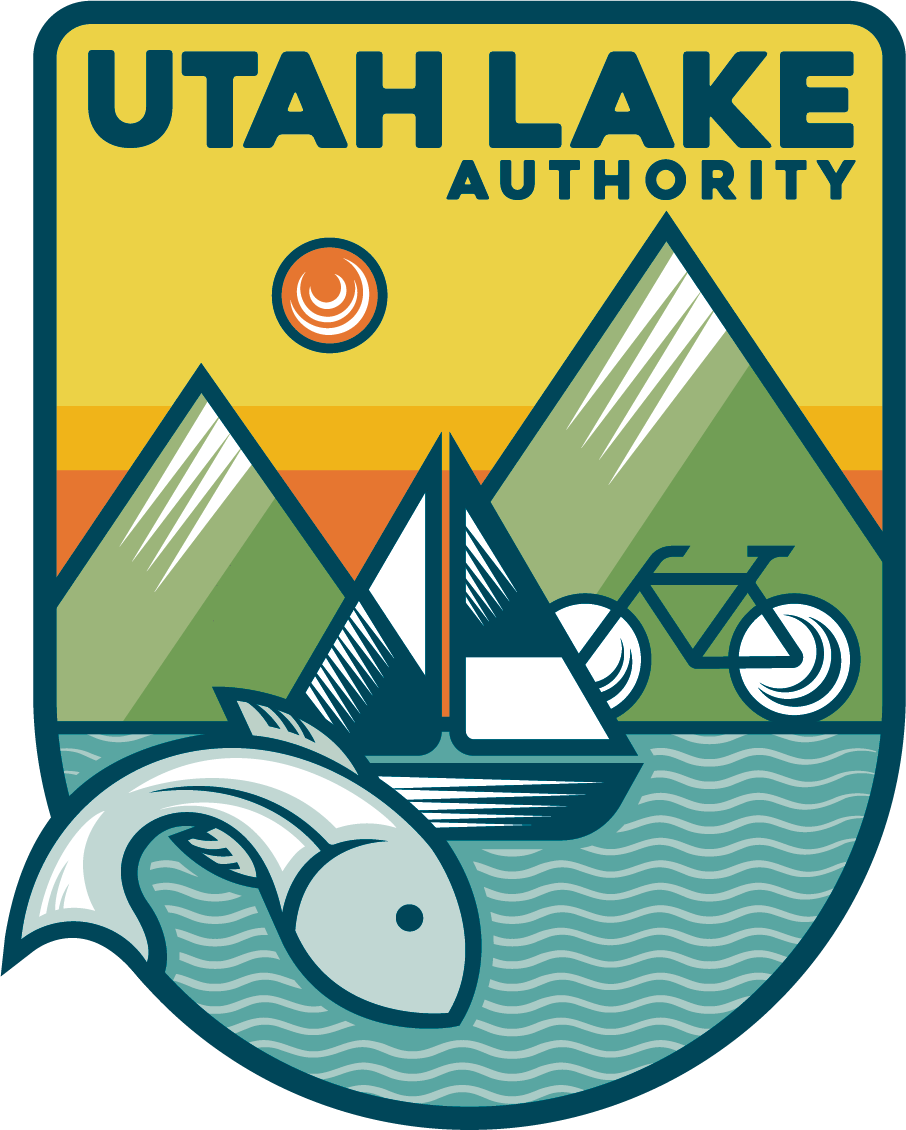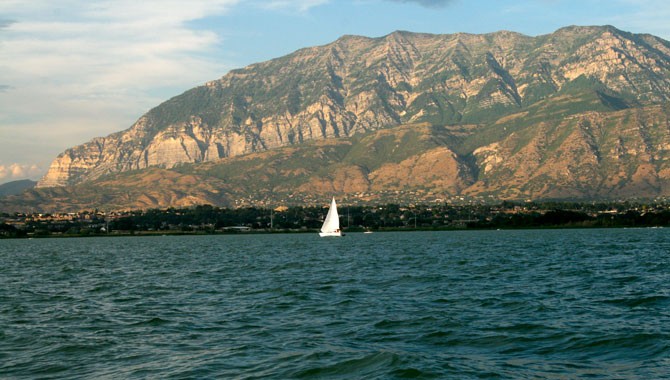When the weather is right, Rick Heninger can reach speeds of 40 miles per hour on Utah Lake. Slow by speedboat standards. But incredible when you consider what Heninger uses to reach said velocity: a modified wakeboard, 75 feet of line, a mini parachute, and lots of wind.
“We are in the water probably more than any other Utah Lake user,” says Heninger, president of the Utah Windriders Association. “The Lake is a great resource for kitesurfers because the wind ramps are humongous!” he says enthusiastically.
Some of his favorite hangouts: “Lincoln Beach and South Sandy Beach near Springville get the most usages due to ideal rising wind (aka “thermals”) throughout the summer,” he says. “When a north frontal weather system moves into the Wasatch, you’ll see windsurfers and kiteboarders ripping it up in the 3-5 five foot chocolaty swell.”
In addition to being some of the most avid Utah Lake users, kitesurfers are also some of its best stewards. “Kiteboarders annually clean up beaches from what inconsiderate people often leave behind,” says Heninger. “Of other Utah Lake enthusiasts, we’d like to think we leave the smallest footprints.”
It’s all worth it, though. “Not even wipeouts or inadvertent gulps of lake water can keep the huge smiles of our faces,” maintains Heninger.
Todd Frye shares similar feelings, although at a much more relaxing pace. “I have been sailing Utah Lake for the past fourteen years, and the feeling of complete freedom and peace has never diminished for me,” says Frye, who operates the Bonneville School of Sailing. (Yes! They have sailing at Utah Lake!)
For Frye, the biggest draw of Utah Lake is its size and proximity. “With a surface area of 96,900 acres, Utah Lake is so big, you quickly gain a reverence for participating in a true wilderness experience. Plus, it’s just 10 minutes from downtown Provo.”
New England not required.
You don’t have to be in the lake to enjoy it, though. Ned Hill, president of the Utah Birding Association and business professor at BYU, has seen everything from night owls and white pelicans, to flocks of Bald Eagles at the Lake.
“Some of my favorite birding experiences have been around Utah Lake,” says Hill. “I have seen Northern Harriers swoop down on an unsuspecting mouse. I’ve seen over 100 American Bald Eagles searching for dead carp a farmer had just tilled into the soil nearby.”
Suddenly, birding doesn’t sound so bland. Nor is it just for senior citizens. “Can you imagine a pack of 30 Cub Scouts standing in the dark in complete silence, straining to listen for the soft voice of a Western-Screech Owl?” Hill asks in reference to a recent birding trip at the Lake. “And the delight in their eyes when the owl flies to a perch on a branch about 15 feet away?”
Not only is birding at Utah Lake an area asset. It’s a national one, says Hill. “When out-of-towners with an interest in birding visit Utah (e.g., James Schlesinger, former Secretary of Defense, last March), one great place to take them is Utah Lake. They always comment what a great natural resource Utah Lake is.”
Of course, what would Utah Lake be without one of its most popular activities: skiing. “Utah Lake’s close proximity, ideal skiing conditions, and light boat traffic are what keeps me coming back,” says Scot Chipman, president of the Utah Water Ski Club. “Very few public lakes around the country offer well protected areas like you can find in Provo Bay.”
Mel Smith echos Chipman’s thinking. “I can be there and ready to make my first ski run in about 30 minutes,” he says. Translation: “I can enjoy an early morning practice session before work and don’t have to plan a whole day on the lake if I don’t want to.”
Smith also shares Heninger’s affinity for the enormity of the Lake, which happens to be one of the largest natural freshwater lake west of the Mississippi. “Because of its size, it’s easy to find an open spot to ski,” says Smith. “So I can be as close as I want to my friends, or as far as I want without being disturbed.”
In terms of prevalence, skiing at Utah Lake is second only to one: the timeless hobby of fishing. “What I have liked about Utah Lake for the past 45 years is the diversity of fish that can be caught almost year round and how good they are to eat,” says Dan “The Fisherman” Potts, an avid angler. “Unlike other bodies of water in the state like Strawberry, where the fish typically go ‘off-flavor’ (fish flavor/texture is no good), Utah Lake never goes off-flavor.”
Not only a good catch, but a tasty one, according to Potts, who credits the lake’s muddy water for protecting the flavor of the fish. “I fished the Lake on Monday with a friend and we caught crappie, bluegill, white bass, and perch. We ate them on Wednesday — they were great. I love to eat the Lake’s fish, including carp.”
That’s not all though. In addition to the above, Utah Lake users can experience boating, swimming, beaches, sightseeing, photography, camping and winter fun to name a few.
Admittedly, Utah Lake isn’t the most acclaimed fresh water lake — many other state reservoirs are renowned for more translucent waters. But those usually come at the price of more crowds, less time on the water, and fewer activities.
“Utah Lake isn’t the most pristine or deepest lake, we get that,” says Reed Price, director of the Utah Lake Commission. “We’re working on remedying the former. Nevertheless, that hasn’t stopped thousands of outdoor enthusiasts from enjoying what the Lake is today: a spacious, convenient, and activity-rich state landmark that’s more diverse than you think.”

